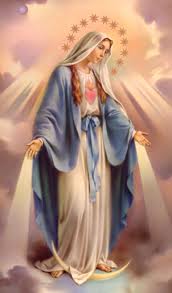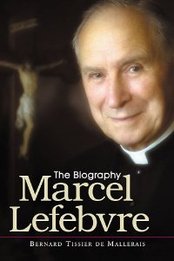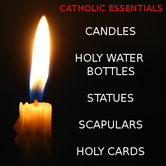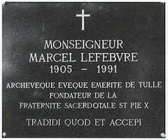
Pope Benedict XIV (+1758) describes Our Blessed Lady as the “heavenly stream which brings to the hearts of wretched mortals all God’s gifts and graces”.
Pope Pius VII (+1823) calls Mary the “Dispensatrix of all graces (gratiarum omnium dispensatricem)”.
Bl. Pius IX (+1878) places his hopes in the Most Blessed Virgin Mary, she who “with her only-begotten Son, is the most powerful Mediatrix and Conciliatrix in the whole world. … (She) who has destroyed all heresies and snatched the faithful people and nations from all kinds of direst calamities; in her do we hope who has delivered us from so many threatening dangers”.
Leo XIII (+1903) writes that “with equal truth may it be also affirmed that, by the will of God, Mary is the intermediary through whom is distributed unto us this immense treasure of mercies gathered by God, for mercy and truth were created by Jesus Christ. Thus as no man goes to the Father but by the Son, so no man goes to Christ but by his Mother”.
In another encyclical, Leo XIII explains that in the vocal recitation of the Rosary we address first the Father who is in heaven and then the Virgin Mary. “Thus is confirmed that law of merciful meditation of which we have spoken, and which St. Bernardine of Siena thus expresses: ‘Every grace granted to man has three degrees in order; for by God it is communicated to Christ, from Christ it passes to the Virgin, and from the Virgin it descends to us’” . At the end of the encyclical the Holy Father, citing the authority of St. Bernard of Clairvaux, reaffirms that God has given us a “Mediatrix” in Mary, willing “that all good should come to us by the hands of Mary”.
In Leo’s Encyclical Adiutricem populi, we read that the Blessed Virgin Mary, “who was so intimately associated with the mystery of human salvation is just as closely associated with the distribution of the graces which for all time will flow from the redemption. … Among her many other titles we find her hailed as ‘Our Lady, our Mediatrix,’ ‘the Reparatrix of the whole world,’ ‘the Dispenser of all heavenly gifts’”.
And in his Encyclical Fidentem piumque we read:
Undoubtedly the name and attributes of the absolute Mediator belong to no other than to Christ, for being one person, and yet both man and God, he restored the human race to the favor of the heavenly Father: One Mediator of God and men, the man Christ Jesus, who gave himself a redemption for all (1 Tim 2:5-6). And yet, as the Angelic Doctor teaches, there is no reason why certain others should not be called in a certain way mediators between God and man, that is to say, in so far as they co-operate by predisposing and ministering in the union of man with God (Summa, p. 3, q. 26., a. 1, 2). Such are the angels and saints, the prophets and priests of both Testaments; but especially has the Blessed Virgin a claim to the glory of this title. For no single individual can even be imagined who has ever contributed or ever will contribute so much towards reconciling man with God. She offered to mankind, hastening to eternal ruin, a Savior, at that moment when she received the announcement of the mystery of peace brought to this earth by the angel, with that admirable act of consent in the name of the whole human race (Summa. p. 3, q. 30., a. 1). She it is from whom is born Jesus; she is therefore truly his mother, and for this reason a worthy and acceptable “Mediatrix to the Mediator”.
St. Pius X (+1914), in the Encyclical Ad diem illum, writes:
It cannot, of course, be denied that the dispensation of these treasures is the particular and peculiar right of Jesus Christ, for they are the exclusive fruit of his death, who by his nature is the mediator between God and man. Nevertheless, by this companionship in sorrow and suffering already mentioned between the Mother and the Son, it has been allowed to the august Virgin to be the most powerful Mediatrix and Advocate of the whole world with her divine Son (totius terrarium orbis potentissima apud unigenitum Filium suum mediatrix et conciliatrix). The source, then, is Jesus Christ. … But Mary … is the channel, or, if you will, the connecting portion the function of which is to join the body to the head and to transmit to the body the influences and volitions of the head—we mean the neck. … We are then, it will be seen, very far from attributing to the Mother of God a productive power of grace—a power which belongs to God alone. Yet, since Mary carries it over all in holiness and union with Jesus Christ, and has been associated by Jesus Christ in the work of redemption … she is the supreme minister of the distribution of graces (princeps largiendarum gratiarum ministra)
Pope Benedict XV (+1922), in the Apostolic Letter Inter sodalicia (March 22, 1918), affirms the role of Mary Co-redemptrix and Mediatrix at the foot of the Cross of her Son:
Mary suffered and, as it were, nearly died with her suffering Son; for the salvation of mankind she renounced her mother’s rights and, as far as it depended on her, offered her Son to placate divine justice; so we may well say that she with Christ redeemed mankind. Consequently … the graces which we receive from the treasury of the redemption are distributed, so to speak, by the hands of this sorrowful Virgin
In the context of the canonization of St. Joan of Arc, Benedict XV observed that “every grace and blessing comes to us” by means of Our Blessed Lady. Therefore, besides the intercession of the saints, “one must include the influence of her whom the Holy Fathers greeted with the title, Mediatrix omnium gratiam”
On January 12, 1921, the Holy See received the requests of Cardinal Mercier (archbishop primate of Belgium) and of the Belgian bishops, approving the Mass and Office of the Feast of the Blessed Virgin Mary Mediatrix of all graces, established on the date of May 31. The liturgical celebration of this feast was granted to the dioceses of Belgium and to all dioceses and religious orders requesting it
With the Apostolic Letter Sodalitatem Nostrae Dominae, Benedict XV granted plenary and partial indulgences to the Sodalizio di Nostra Signora della buona morte (Association of Our Lady of a Happy Death); he also granted indulgences for the day of May 31, Feast of the Blessed Virgin Mary “Mediatrix of all graces”
Pius XI (+1939) calls the Virgin Mary the “Mediatrix of all graces with God” ; he writes that Christ has associated Mary with himself as “minister and mediatress of grace” ; he makes reference to the most efficacious patronage of the Blessed Virgin Mary “Mediatrix of all graces”; he establishes the Blessed Virgin Mary of graces of Mount Philerimos as the principal patroness of the Archdiocese of Rhodes; and, in the related document, the Blessed Virgin is called “Mediatrix of all graces”.
Pius XII (+1958) very often makes use of the titles Mediatrix omnium gratiarum, gratiarum omnium apud Deum sequestra, and other similar expressions. In the Encyclical Ad Caeli Reginam, Pius XII wonderfully illustrates the doctrine of the Blessed Virgin Mary’s universal mediation:
Certainly, in the full and strict meaning of the term, only Jesus Christ, the God-man, is King; but Mary, too, as Mother of the divine Christ, as his associate in the redemption, in his struggle with his enemies and his final victory over them, has a share, though in a limited and analogous way, in his royal dignity. For from her union with Christ she attains a radiant eminence transcending that of any other creature; from her union with Christ she receives the royal right to dispose of the treasures of the divine Redeemer’s kingdom; from her union with Christ finally comes the inexhaustible efficacy of her maternal intercession before the Son and his Father. Hence it cannot be doubted that Mary most holy is far above all other creatures in dignity, and after her Son possesses primacy over all. …
For if through his humanity the divine Word performs miracles and gives graces, if he uses his sacraments and saints as instruments for the salvation of men, why should he not make use of the role and work of his most holy Mother in imparting to us the fruits of redemption? “With a heart that is truly a mother’s,” to quote again our predecessor of immortal memory, Pius IX, “does she approach the problem of our salvation, and is solicitous for the whole human race; made Queen of heaven and earth by the Lord, exalted above all choirs of angels and saints, and standing at the right hand of her only Son, Jesus Christ our Lord, she intercedes powerfully for us with a mother’s prayers, obtains what she seeks, and cannot be refused.” On this point another of our predecessors of happy memory, Leo XIII, has said that an “almost immeasurable” power has been given Mary in the distribution of graces; St. Pius X adds that she fills this office “as by the right of a mother”.
Bl. John XXIII (+1962) granted the title and privilege of minor basilica to the church dedicated to the Blessed Virgin Mary Mediatrix of All Graces, Sultana of Africa, located in the locality of Lodonga, in Uganda. In the text of the related apostolic letter there are three references to the “Mediatrix of all graces”.




